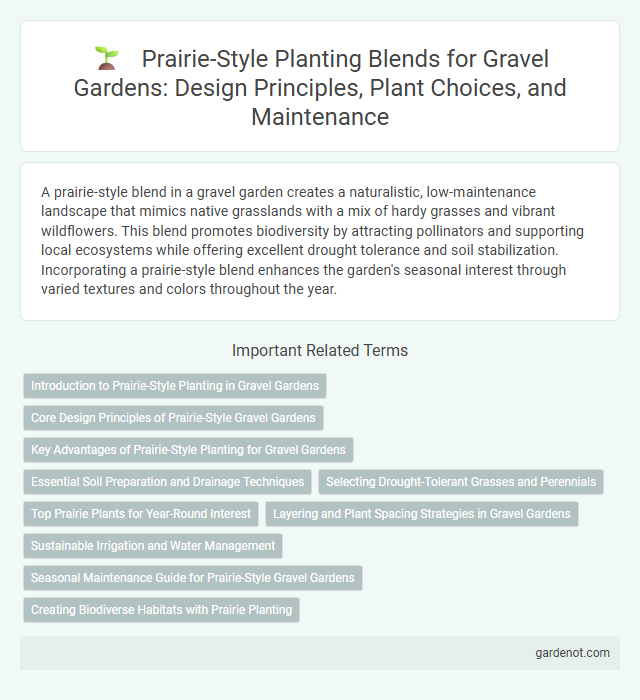A prairie-style blend in a gravel garden creates a naturalistic, low-maintenance landscape that mimics native grasslands with a mix of hardy grasses and vibrant wildflowers. This blend promotes biodiversity by attracting pollinators and supporting local ecosystems while offering excellent drought tolerance and soil stabilization. Incorporating a prairie-style blend enhances the garden's seasonal interest through varied textures and colors throughout the year.
Introduction to Prairie-Style Planting in Gravel Gardens
Prairie-style planting in gravel gardens emphasizes a naturalistic blend of native grasses and wildflowers that thrive in well-drained, sandy soils. Key species include little bluestem (Schizachyrium scoparium), purple coneflower (Echinacea purpurea), and black-eyed Susan (Rudbeckia hirta), all adapted to drought conditions and low maintenance. This approach enhances biodiversity, supports pollinators, and creates resilient, textural landscapes that mimic native prairie ecosystems.
Core Design Principles of Prairie-Style Gravel Gardens
Prairie-style gravel gardens emphasize naturalistic planting with drought-tolerant native grasses and wildflowers arranged in layered, horizontal patterns to mimic prairie landscapes. Core design principles include seamless integration with the surrounding environment, use of varied textures and colors to create visual depth, and sustainable maintenance practices that enhance soil health and biodiversity. This approach balances aesthetic appeal with ecological function, promoting resilience and seasonal interest in gravel garden settings.
Key Advantages of Prairie-Style Planting for Gravel Gardens
Prairie-style planting in gravel gardens enhances biodiversity by incorporating native grasses and wildflowers that thrive in well-drained soils, reducing the need for irrigation and chemical inputs. This approach promotes year-round interest with dynamic textures and seasonal blooms, creating a resilient and low-maintenance landscape. Its deep-rooted plants improve soil structure and stormwater infiltration, contributing to sustainable garden ecosystems.
Essential Soil Preparation and Drainage Techniques
Prairie-style gravel gardens thrive on well-drained, nutrient-rich soil achieved by incorporating organic matter such as compost and coarse sand to enhance aeration and moisture retention. Proper grading ensures water flows away from plant roots, preventing waterlogging and promoting healthy root development. Installing a subsurface drainage layer with gravel or crushed stone further optimizes soil drainage, supporting drought-tolerant prairie plants.
Selecting Drought-Tolerant Grasses and Perennials
Selecting drought-tolerant grasses and perennials like little bluestem, switchgrass, and purple coneflower creates a resilient prairie-style gravel garden. These native plants thrive in well-drained, sandy soils, reducing water requirements while promoting biodiversity. Incorporating varieties such as blue oat grass and black-eyed Susan enhances texture and color throughout dry seasons.
Top Prairie Plants for Year-Round Interest
Prairie-style gravel gardens showcase a diverse blend of native grasses and flowering perennials such as little bluestem, purple coneflower, and prairie dropseed, providing continuous visual appeal throughout the seasons. These top prairie plants thrive in well-drained, gravelly soil, offering drought tolerance and low maintenance while attracting pollinators like bees and butterflies. Incorporating species like blazing star and switchgrass enhances texture and color, ensuring year-round interest and ecological benefits in the garden.
Layering and Plant Spacing Strategies in Gravel Gardens
Prairie-style blends in gravel gardens emphasize diverse plant layering, combining tall grasses like Little Bluestem with low-growing perennials such as Coreopsis for texture and visual interest. Strategic plant spacing ensures robust root systems, reduces competition, and promotes air circulation to mitigate disease risks in arid gravel settings. Adopting these layering and spacing techniques enhances drought tolerance and supports native pollinator habitats, creating sustainable and vibrant gravel garden ecosystems.
Sustainable Irrigation and Water Management
Prairie-style gravel gardens utilize native, drought-resistant plants that thrive with minimal water, promoting sustainable irrigation practices. The deep root systems of prairie species enhance soil permeability, reducing runoff and optimizing water retention. Incorporating permeable gravel beds further supports efficient water management by minimizing evaporation and facilitating natural groundwater recharge.
Seasonal Maintenance Guide for Prairie-Style Gravel Gardens
Prairie-style gravel gardens benefit from seasonal maintenance that emphasizes natural growth cycles and soil health. In spring, remove debris and thin dense plant clusters to encourage airflow and prevent diseases, while summer requires consistent monitoring for weeds and supplemental watering during droughts. Autumn involves cutting back spent grasses and perennials, leaving seed heads for winter interest and wildlife sustenance, followed by a light mulch to protect roots during cold months.
Creating Biodiverse Habitats with Prairie Planting
Prairie-style blends in gravel gardens enhance biodiversity by incorporating native prairie grasses and wildflowers that support local pollinators and wildlife. These drought-tolerant plants thrive in well-drained gravel soil, creating dynamic habitats that mimic natural prairie ecosystems. Combining deep-rooted perennials with varied bloom times ensures continuous food sources and shelter for insects, birds, and small mammals.
Prairie-style blend Infographic

 gardenot.com
gardenot.com